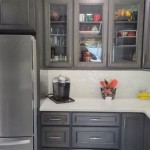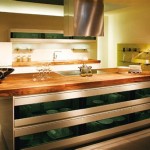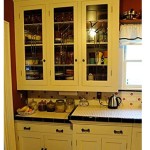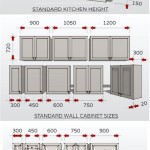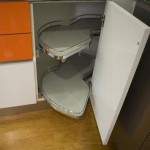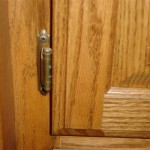How to Remove a Kitchen Cabinet Above the Fridge
Removing a kitchen cabinet above the refrigerator can be necessary for various reasons, including replacing the cabinet, upgrading the appliance to a taller model, or simply altering the kitchen's layout. This task, while seemingly simple, requires careful planning and execution to avoid damaging surrounding structures, the existing cabinet, or oneself. This article provides a detailed guide on safely and effectively removing a kitchen cabinet situated above a refrigerator.
Planning and Preparation
Prior to initiating the removal process, a thorough assessment of the situation is essential. This involves identifying the cabinet's construction, its attachment method, and the surrounding conditions. Understanding these aspects will dictate the tools and techniques required for a successful removal.
Firstly, examine the cabinet's construction. Is it a framed or frameless cabinet? Framed cabinets typically feature a face frame around the cabinet box, which often provides additional structural support. Frameless cabinets, also known as European-style cabinets, lack this face frame and rely on the cabinet box itself for strength. Identifying the construction type influences the sequence of disassembly. A framed cabinet might allow for easier removal of individual components before detaching the entire unit, while a frameless cabinet may require a more unified approach.
Secondly, determine how the cabinet is attached to the surrounding structures. Most commonly, cabinets are secured to wall studs using screws or nails. These fasteners might be visible, hidden behind cabinet trim, or concealed under layers of paint or caulk. Exploring the inside of the cabinet and examining the points where it meets the adjacent cabinets or the wall is crucial. Check for screws that pass through the cabinet frame and into the wall studs. In some installations, the cabinet might also be glued to the wall in addition to being screwed, making removal more challenging.
Thirdly, assess the surrounding conditions. Note the presence of any electrical wiring or plumbing lines in close proximity to the cabinet. Refrigerators frequently have electrical outlets located behind them, and sometimes plumbing for ice makers or water dispensers. Exercise extreme caution when working near these services. Turn off the circuit breaker supplying power to the outlet behind the refrigerator before starting any work. If plumbing is present, shut off the water supply to avoid potential leaks. Also, consider the flooring material. Protect delicate surfaces like hardwood or tile with drop cloths or cardboard to prevent scratches or damage from falling debris.
Finally, gather the necessary tools and materials. This includes a stud finder, screwdriver (both Phillips and flathead), drill with appropriate bits, utility knife, pry bar, hammer, level, safety glasses, work gloves, and shims. A reciprocating saw or oscillating multi-tool might be necessary if the cabinet is heavily glued or if precise cuts are required. A helper is highly recommended to assist with supporting the cabinet during removal and to prevent it from falling unexpectedly.
Step-by-Step Removal Process
After completing the planning and preparation phase, the actual removal process can begin. This process involves several distinct steps, each requiring attention to detail to ensure safety and minimize damage.
Step 1: Empty the Cabinet. The initial step is to completely empty the cabinet. Remove all contents, including dishes, food items, and any other stored materials. This reduces the weight of the cabinet, making it easier to handle and reducing the risk of injury during removal. Even a seemingly light cabinet can become heavy when awkward to manipulate. After emptying, remove any adjustable shelves. These are usually held in place by shelf pins or clips. Carefully detach these and store them in a safe location for later use if the cabinet is to be reinstalled elsewhere.
Step 2: Disconnect Appliances (if applicable). If the refrigerator has an ice maker or water dispenser connected to a water line, disconnect the water supply. Turn off the water supply valve typically located under the sink and disconnect the water line from the refrigerator. Have a bucket and towels ready to catch any residual water in the line. Unplug the refrigerator from the electrical outlet. Ensure the refrigerator is free to move without any obstructions from wires or hoses. Gently pull the refrigerator away from the wall to create sufficient working space behind the cabinet.
Step 3: Remove Trim and Molding. Many cabinets have decorative trim or molding installed around their perimeter. This trim is usually attached with small nails or adhesive. Use a utility knife to carefully score along the edges of the trim where it meets the cabinet or the wall. This helps to prevent paint from peeling when the trim is removed. Insert a pry bar or putty knife behind the trim and gently pry it away from the cabinet. Work slowly and carefully to avoid damaging the trim or the surrounding surfaces. If the trim is glued, it might be necessary to use a heat gun to soften the adhesive or an oscillating multi-tool to carefully cut through it.
Step 4: Locate and Remove Fasteners. Use a stud finder to locate the wall studs behind the cabinet. Mark the location of the studs on the cabinet's interior. Examine the inside of the cabinet for screws or nails that attach it to the wall studs or adjacent cabinets. Use a screwdriver or drill to remove these fasteners. If the screws are stripped or difficult to remove, try using a screw extractor or a larger screwdriver. If nails are used, use a nail punch and hammer to drive them through the back of the cabinet. Pay close attention to fasteners located along the top edge of the cabinet, as these are often the primary support points.
Step 5: Separate the Cabinet (If Glued). If the cabinet is glued to the wall, carefully use a utility knife or an oscillating multi-tool to cut through the adhesive. Work slowly and methodically, ensuring that the blade penetrates the entire thickness of the adhesive. A reciprocating saw with a fine-tooth blade can also be used, but exercise caution to avoid damaging the wall. Insert a wide putty knife or thin pry bar between the cabinet and the wall and gently tap it with a hammer to help break the adhesive bond. Work around the perimeter of the cabinet, gradually separating it from the wall.
Step 6: Support the Cabinet. Before completely detaching the cabinet, it is crucial to provide adequate support to prevent it from falling. Have a helper support the cabinet from below. Alternatively, insert shims between the top of the refrigerator and the bottom of the cabinet to provide temporary support. Ensure the shims are securely in place and can bear the weight of the cabinet.
Step 7: Remove the Cabinet. With the cabinet supported, carefully detach the remaining fasteners. Double-check for any hidden screws or nails that might have been missed. Once all fasteners are removed and the cabinet is fully separated from the wall, gently lower it to the floor. With a helper, lift the cabinet down carefully. Ensure it is placed on a protected surface to prevent damage. If the cabinet is too heavy to safely lift down, consider disassembling it further before removal.
Post-Removal Procedures
After removing the cabinet, several tasks remain to ensure the area is clean, safe, and ready for any subsequent steps.
Patching Walls: The removal process will likely leave holes in the drywall or plaster. Use drywall compound or spackle to fill these holes. Apply the compound in thin layers, allowing each layer to dry completely before applying the next. Sand the patched areas smooth and prime them before painting to match the surrounding wall color. This creates a seamless and professional finish.
Cleaning and Disposal: Clean the area around the refrigerator and remove any debris, such as sawdust, screws, or nails. Dispose of the old cabinet properly. Depending on its condition, it might be possible to donate it to a charity or repurpose it for another project. If disposal is necessary, check local regulations for proper disposal methods. Some municipalities have specific guidelines for disposing of large items such as cabinets.
Addressing Electrical and Plumbing: If any electrical wiring or plumbing lines were accessed during the removal process, ensure they are properly insulated and protected. Replace any damaged insulation or fittings. If no further work is planned in the area, consider covering the electrical outlet behind the refrigerator with a blank cover plate to prevent accidental contact. If plumbing lines were disconnected, ensure they are properly capped off to prevent leaks.
Reinstalling the Refrigerator: Once the area is cleaned and prepared, carefully push the refrigerator back into its original position. Reconnect the water line and electrical plug. Ensure the refrigerator is level and properly aligned. Clear any obstructions from around the refrigerator to allow for proper ventilation.
By following these steps carefully and taking the necessary precautions, the removal of a kitchen cabinet above the refrigerator can be accomplished safely and effectively. Always remember to prioritize safety and seek professional assistance if unsure about any aspect of the process.

Relocating The Cabinet Above Fridge

Removing Some Kitchen Cabinets Rehanging One Young House Love

Relocating The Cabinet Above Fridge

Relocating The Cabinet Above Fridge

Removing Some Kitchen Cabinets Rehanging One Young House Love

Remove Cabinets Above Fridge Add Back Splash To Match Rest Of Kitchen And Then There Is No More Ju Refrigerator Decor

Building In A Fridge With Cabinet On Top Thrifty Decor Diy And Organizing

Removing Some Kitchen Cabinets Rehanging One Young House Love

Surrounding The Fridge Plaster Disaster
How To Build A Refrigerator Cabinet Surround Ana White
Related Posts

